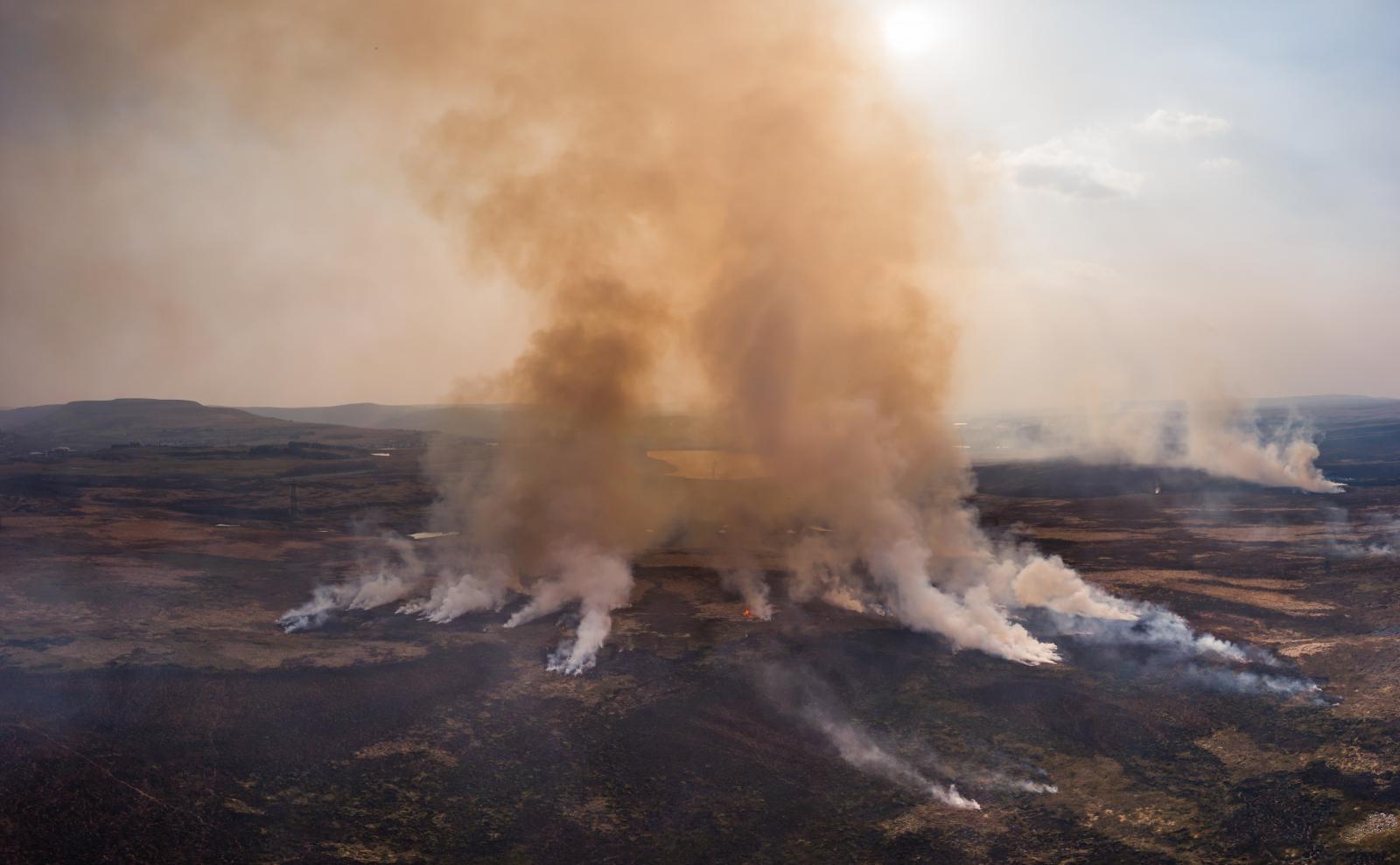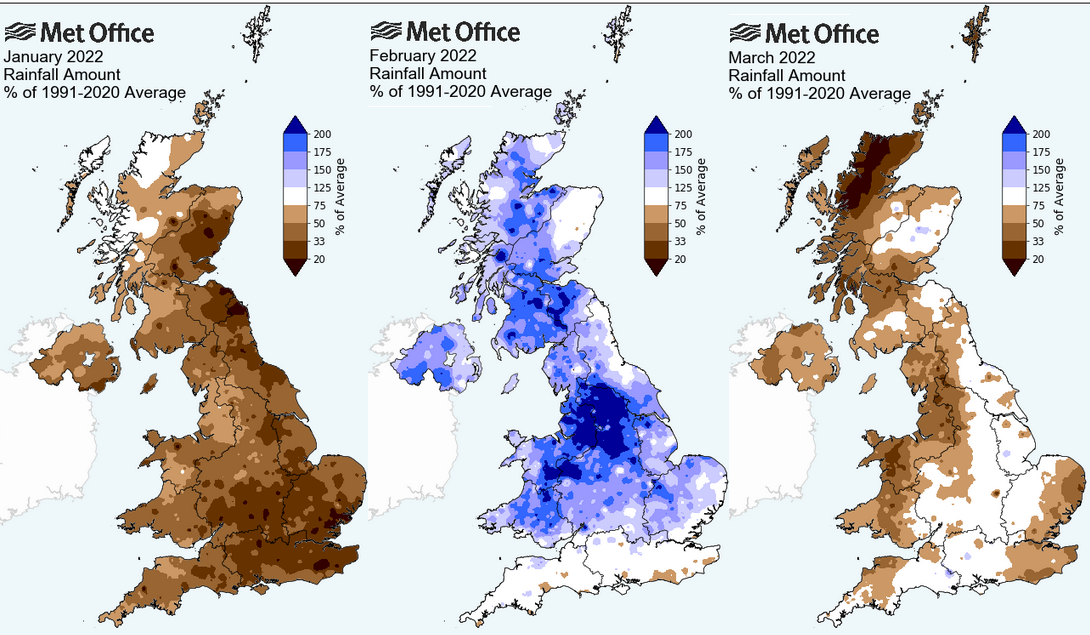
It has been dry for while now and spring often sees an increase in wildfire callouts, especially around holiday weekends. With little rain forecast this week there are pleas to take care in the countryside.
In the runup to the early May Bank Holiday weekend, Fire & Rescue teams are repeating their safety advice as more people head out in the dry weather and warm sunshine. For managing fire risk and staying safe near water. The outlook for the rest of the month is settled and dry. Not overly warm, the air is still cool but the sun's rays are strong now. Very little rain coming towards the UK at least until the second half of the weekend. And even that has low confidence, if it will arrive from the northwest.
# BeMoorAware
Any fine UK weather will be celebrated and enjoyed by those with time off work. Warm sunshine can make open water seem appealing, although the air still has a cool edge to it this week in the shade and particularly by night so cold-water shock is being highlighted. Also, the risk of wildfires, although the dry weather is only one part of the fire risk picture. Both water rescue and tackling wildfires are, unfortunately, in the news too often.
“Every year fire is responsible for the destruction of thousands of hectares of countryside, open space and wildlife habitats”
Last weekend the Dorset & Wiltshire service mobilised 15 pumps, 6 off-road landrovers and 4 water carriers to attend a heathland fire at Canford Heath. Although the fire was mainly on rural land, it did threaten people’s homes with evacuations of some properties later on Sat. April 23rd. With visible flames and huge amounts of smoke, it was an alarming event aided by blustery winds.

There was also a heath fire at Lodmoor Country Park, Weymouth requiring three appliances with two landrover pumps on the same day. This then led to temporary water supply issues in the area.
“Wildfires are very dangerous, spreading fast, changing direction, jumping to and from other areas potentially threatening life. If you see a fire, however small, call 999 immediately. “
There has only been a few, isolated showers since then. High pressure has dominated our recent weather, with the Atlantic jetstream weak or split in two. Low pressures have often been closer to Portugal and Spain bringing unsettled weather to Iberia and other lows nipping away to the north for Iceland and northern Norway. High pressure to the north gave us an easterly flow but that low has now sunk over the UK, so dry and settled weather remains.
In an easterly flow, Wales, western England and western Scotland will often be dry and sunny, even warm in spring. This setup can heighten the fire risk. It brings low relative humidity but brisk winds to fan any flames. This happened in Dorset.

It’s been dry for much of the UK in April. This follows on from a dry March and dry January, but February was wetter away from southern England. Data from the Environment Agency in England showed a very dry week 13th- 19th April with River Levels now at normal levels or below. Some in SW England are notably low. We await the monthly data from the UK Met Office for April’s rainfall.
The preceding weather can also affect the fuel available to burn. Cold, frosty weather can alter plants or restrict their growth, even damage parts. This leaves plants, such as heather, with less moisture by spring but a higher potential for ignition and so wildfires. Dec21 was frosty for inland Scotland and parts of northern UK in Mar22. Jan22 was frosty for England and Wales away from the far north.
EFFIS is the European Forest Fire Information System and open to all European countries. The above data is for the UK 25/04/22
Spring can often bring a peak in wildfire activity for the UK. Natural England is already partnering with Fire and Rescue Services in Yorkshire to raise awareness of wildfires ahead of the spring/summer period, when higher temperatures and dry weather increases the risks as more people venture out. This will protect the environment but also lessen the strain on firefighters who might be needed elsewhere.
Fire & Rescue teams are called upon to deal with grassland/woodland and crop fires with moorland, particularly peat or heather upland fires being very difficult to contain. There is the use of resources, costs and damage along with impacts to agriculture, forestry, wildlife, recreational interests and property, even life.
Looking across Europe there have already been outbreaks and plenty of warnings for wildfires. With climate change, more are expected as summers become hotter with lengthy dry spells resulting in heatwaves and drought. Wildfires then add to air pollution and damage crops affecting food security, along with other dangers where rural fires meet urban areas. And of course, the drain on valuable water resources.
Managing this risk is important, not just the actual firefighting but how to prepare and prevent at least some of the fires, and the impacts.
The Met Office's Fire Severity Index (FSI), is an assessment of how severe a fire could become if one were to start. It is not an assessment of the risk of wildfires occurring.
The Met Office Fire Severity Index (MOFSI, Met Office 2003) model covers England and Wales. A Scotland project is underway.
“Wildfire - Any uncontrolled vegetation fire which requires a decision, or action, regarding suppression” (Scottish Government 2013)”
Fire Danger Rating Systems (FDRS) look at fire-related vegetation characteristics (its moisture, combustibility), current & past weather with climate data and then produce outputs of the level of fire risk. It includes east of ignition, fire spread and the intensity of fires along with how difficult it will be to control and the likely impacts.
The Canadian Forest FDRS is one of the most widely used, globally and the Met Office use the Fire Weather Index (FWI) part. It has to be adapted for local conditions, which is proving tricky for the upland moorlands of heather and peat bogs in Scotland, the fuel aspect.
“takes into account simulated moisture conditions at various levels through the soil and incorporates the following weather elements: temperature, relative humidity, wind speed and rainfall, to quantify the likely severity of potential fire…for five days ahead on a 10-km square grid in terms of a 1 to 5 rating with Level 5 representing ‘exceptional’ conditions when, if a fire occurs, it is likely to be extremely difficult to control. It does not provide an assessment of the risk of wildfire actually occurring” MO 2003
"The key issues over the next few days are sunshine, warm air temperatures, low humidity and moderate to strong winds. Dead grass, leaves, twigs and heather on the ground will dry quite quickly in these conditions and when ignited can burn very fast with extreme fire intensity." Scottish F&R
This is a tool to be used for forecasting but alongside are timely campaigns from Fire & Rescue services, councils and community groups. This is on-the-ground advice or at times, accompanied by stronger, legal orders. PSPOs are Public Space Protection Orders accompanied by fines. They temporarily protect vulnerable areas such as Barnsley moorland.
“Activities such as using disposable barbecues, fireworks and sky lanterns will be outlawed in order to protect the moors following incidents at local beauty spots” March 2022
Outdoor activity particularly camping in springtime along with better weather, bring a peak in wildfire occurrences along with land management burning, such as upland muirburn (although that season is now coming to an end). Outdoor recreational fires are the main cause of out of control fires at low levels. BBQs also feature, and to a lesser extent cigarettes with other litter including glass.

In spring, there is plenty of vegetation (fuel), and even if it isn’t hot, with dry air and a breeze, parts of the UK often see an enhanced fire risk at this time of year. Every week there are call outs for smaller fires, many accidental but fine weather Bank Holidays can bring extra incidents. Hence the Fire & Rescue services highlighting their advice.
Disposing of cigarettes properly. Make sure that rubbish goes in a suitable bin or take it home. Do not have open fires or BBQs in the countryside. They can easily set fire to the ground and spread,
“If you find a fire in the countryside don’t attempt to tackle it, call 999 and ask for the fire service immediately. Pass as much information about the location as possible, use the app What 3 Words if you have it to pinpoint the exact spot.”
The same for a campfire or BBQ which has spread to the ground or surrounding shrubbery, phone 999. Not just in the countryside but in people’s gardens. That they are “placed well away from the home and property, including sheds, garages, overhanging trees and shrubs and garden waste. Never leave a barbecue unattended, especially when there are children or pets around. Always keep a bucket of water or hose pipe on hand and in an emergency, ring 999 immediately.”
For people camping, maybe further afield, there will be advice from the local council or countryside rangers about what is allowed and where.
If you do use a disposable barbecue, in an allowed area: Only use it on an even surface, such as concrete, bricks or paving slabs. Think about how you are going to dispose of it before you head out or use it. Ensure it has cooled before putting it in the bin. To avoid starting a fire you should allow it to cool for several hours and then consider pouring water over it to make sure it's completely out.
One important and successful community outreach project has been sharing information about the consequences of setting fires deliberately with young people. Keep matches and lighters out of children and young peoples' reach and talk to them about the dangers of starting fires outside. Many wildfires are from accidents but not all. Firestoppers, part of Crime Stoppers 0800 169 5558 is for anonymous information following a deliberate fire incident. Some fires occur from re-ignition, particularly in more remote areas.
Do think about the local advice and conditions. It has been dry for a while now in many parts of the UK with fires already breaking out and having to be tackled. There will be plenty of dry weather over the next few days and we’ll wait to see how much rain manages to reach in from the Atlantic as the long weekend progresses.